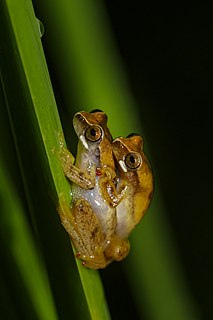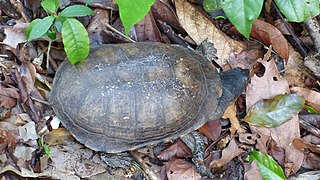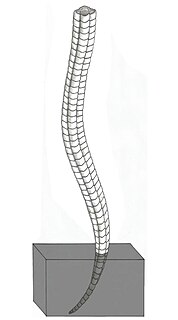
Kleinmann's tortoise, also called commonly the Egyptian tortoise, Leith's tortoise, and the Negev tortoise, is a critically endangered species of neck-hiding tortoise in the family Testudinidae. The species is native to Egypt, Libya, and Israel. The species was once more widespread, but its numbers are now dwindling. The species is nearly extinct in Egypt, and complete extinction in the wild is a looming threat unless more actions are taken to protect this species.

Franz Josef Maria Werner was an Austrian zoologist and explorer. Specializing as a herpetologist and entomologist, Werner described numerous species and other taxa of frogs, snakes, insects, and other organisms.

The Bailey's treefrog is a species of frog in the family Hylidae. It is endemic to southern Brazil. Its natural habitats are subtropical or tropical seasonally wet or flooded lowland grassland, swamps, freshwater marshes, intermittent freshwater marshes, pastureland, and seasonally flooded agricultural land.
Achalinus werneri, also known commonly as the Amami odd-scaled snake and the Amami Takachiho snake, is a species of snake in the family Xenodermatidae. The species is endemic to the Ryukyu Islands, Japan. There are no subspecies that are currently recognized.
The spatula-toothed snake is a species of snake in the family Colubridae. The species is endemic to Indonesia.

The Brazilian radiolated swamp turtle is a species of turtle in the Chelidae family endemic to Brazil.
Niveria werneri is a species of small sea snail, a marine gastropod mollusk in the family Triviidae, the false cowries or trivias.
Hysterocladia is a genus of moths in the family Megalopygidae.

Corumbella is an extinct genus of terminal-Ediacaran cnidarians. It is the only genus in the monotypic family Corumbellidae, and is represented by a single species Corumbella werneri. It possessed a carapace made up of thick polygonal rings in which plates with pores and papillae attest to the advent of skeletogenesis in latest Neoproterozoic metazoan. It was a sessile predator and somewhat resembles the later conulariids.
Cephalocladia werneri is a moth of the family Megalopygidae. It was described by Walter Hopp in 1927. It is found in Colombia.
Hysterocladia servilis is a moth of the family Megalopygidae. It was described by Walter Hopp in 1927. It is found in Peru.
Hysterocladia tolimensis is a moth of the family Megalopygidae. It was described by Walter Hopp in 1927. It is found in Colombia.
Hysterocladia elongata is a moth of the family Megalopygidae. It was described by Walter Hopp in 1927. It is found in Peru.
Hysterocladia ferecostata is a moth of the family Megalopygidae. It was described by Walter Hopp in 1927. It is found in Peru.
Hysterocladia primigenia is a moth of the family Megalopygidae. It was described by Walter Hopp in 1927. It is found in Peru.
Hysterocladia corallocera is a moth of the Megalopygidae family. It was described by Felder in 1874. It is found in Venezuela and French Guiana.
Hysterocladia eriphua is a moth of the Megalopygidae family. It was described by Paul Dognin in 1914. It is found in Panama.
Hysterocladia lena is a moth of the Megalopygidae family. It was described by Schaus in 1912. It is found in Costa Rica.
Hysterocladia roseicollis is a moth of the Megalopygidae family. It was described by Paul Dognin in 1914. It is found in Peru and French Guiana.
Hysterocladia unimana is a moth of the family Megalopygidae. It was described by Walter Hopp in 1943. It is found in Brazil.




